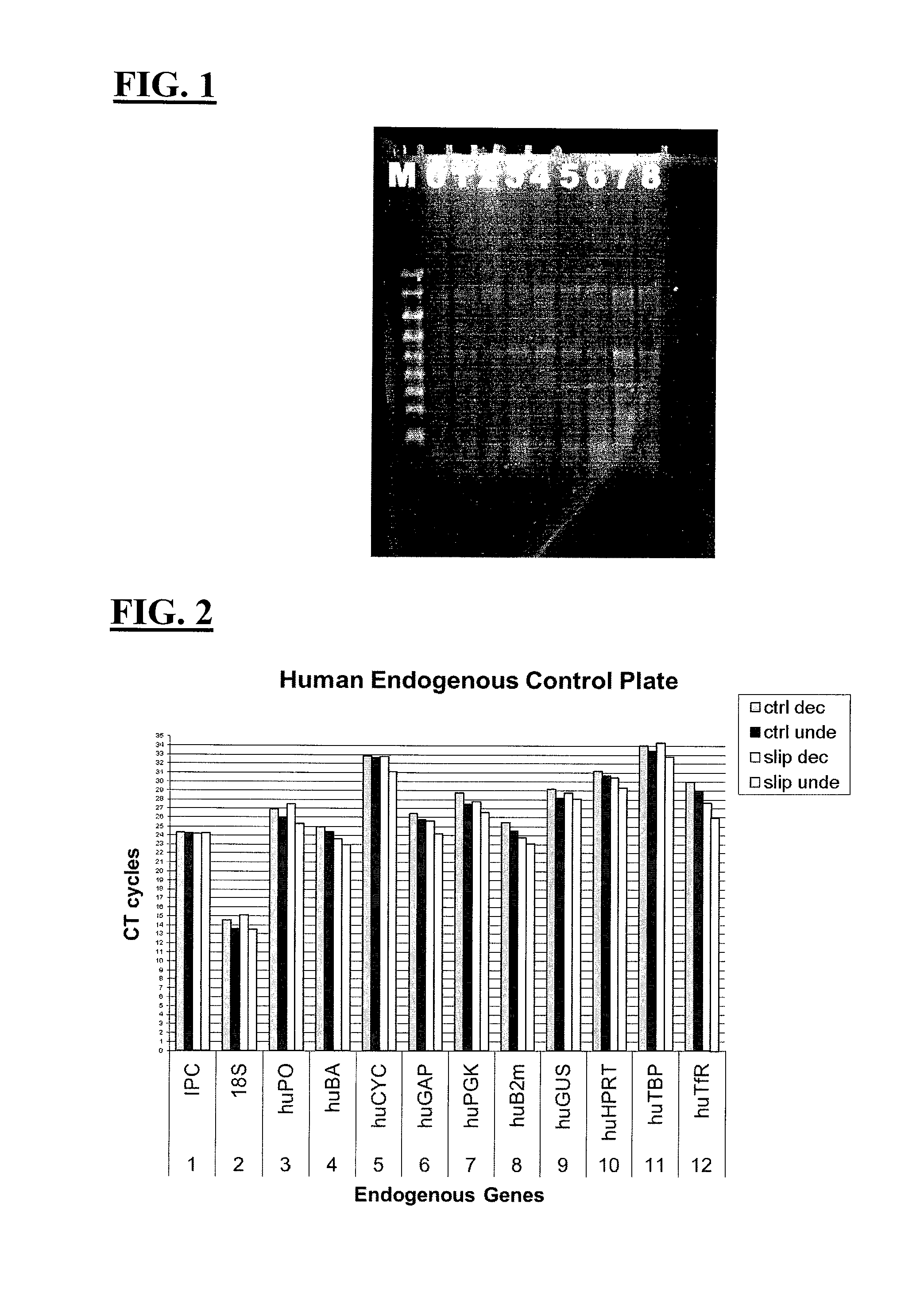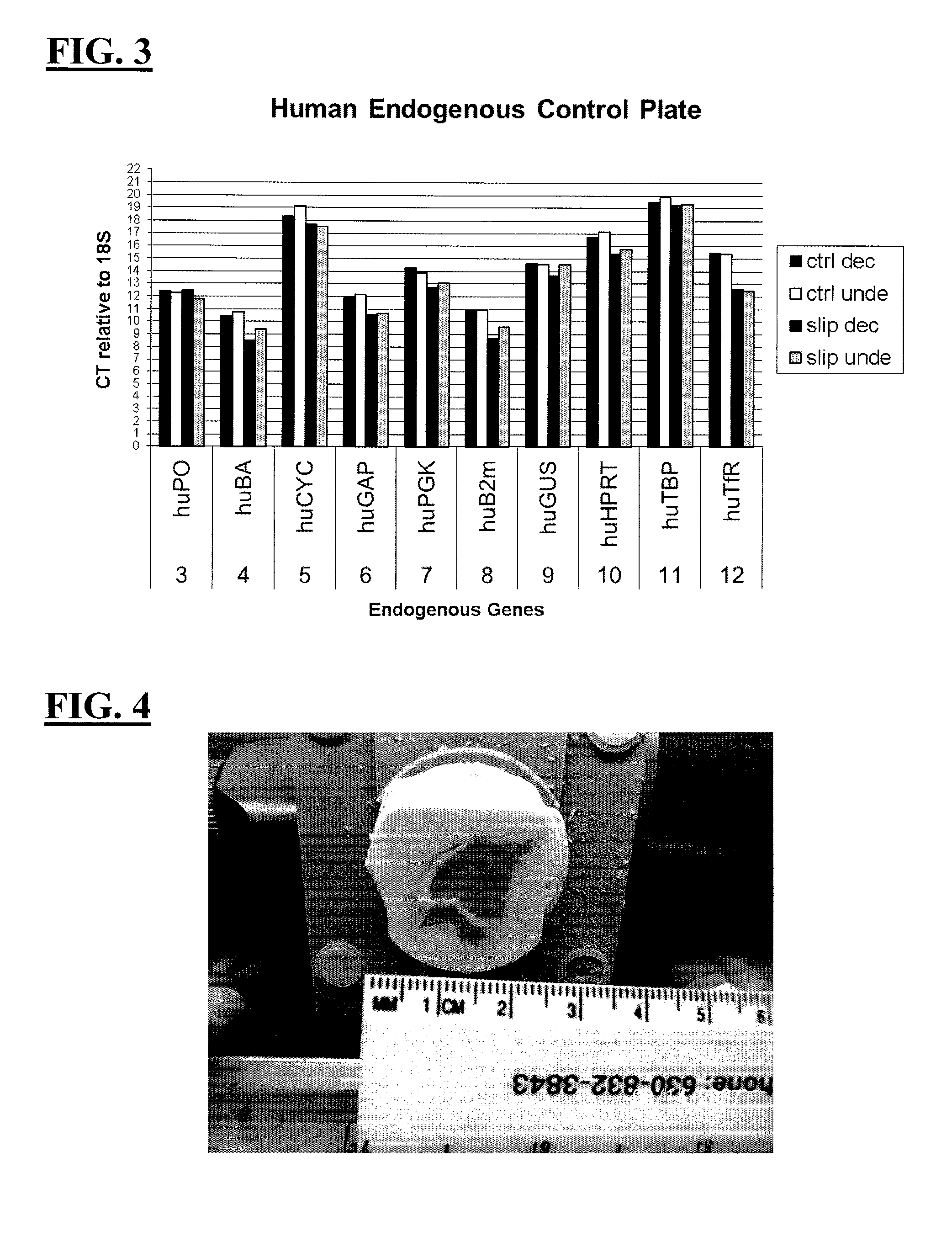Decalcification Solution with Preservation of RNA
a technology of decalcification solution and rna, applied in the field ofmolecular biology, can solve the problems of difficult cutting or sectioning effective, difficult to examine and analyze hard tissues such as bones and teeth, cryostats, etc., and achieve the effect of hard sectioning
- Summary
- Abstract
- Description
- Claims
- Application Information
AI Technical Summary
Benefits of technology
Problems solved by technology
Method used
Image
Examples
example 1
Synthesis of a Standard 50 ml Decalcification Solution According to One Embodiment of the Present Invention
[0066]40 ml of RNAlater® was measured into a 100 ml baked beaker (RNase-free) at room temperature. 5 g tetrasodium-EDTA (ethylenediaminetetra-acetic acid) salt was then added as a decalcification agent. The solution pH was then adjusted to be above 8.0 by drop wise addition of 10% NaOH. The solution was stirred for about 30 minutes, until all of the tetrasodium-EDTA salt had dissolved. The solution volume was then adjusted to 50 ml with additional RNAlater® and the pH readjusted to 7.6 by dropwise addition of 6N HCl. The total solution was then sterilized by passing it through a 0.2 μm filter into a sterile conical tube.
example 2
Analysis of RNA Integrity after Decalcification of Mouse Bone Samples for Sectioning within a Short Time Frame
[0067]First, 5 G of ethylenediamine tetraacetic acid as a tetrasodium salt was placed in 40 ml of RNAlater® Solution (Ambion, Life Technologies). When the tetrasodium-EDTA did not initially dissolve, the pH was increased to above 8.0 by the addition of sodium hydroxide (10N) with stirring for 30-60 min. After dissolution, the pH was decreased to 7.6 with acid (6N HCL). The solution volume was adjusted to a final volume of 50 ml with RNAlater® Solution. The homogenous mixture was sterile filtered through a 0.2 μm filter in preparation for use. This solution was used in an initial experiment to determine time frame of the process of decalcification in relation to RNA degradation and feasibility of its use at 10% tetrasodium-EDTA concentration.
[0068]Second, sixteen mouse tibial bones (left and right rear sides), 1.6-1.9 cm in length and less than 5 mm in diameter, were harveste...
example 3
Analysis of RNA Integrity after Decalcification of Rat Bone Samples for Sectioning within a Short Time Frame
[0073]First, 10.0 grams of tetrasodium-EDTA was weighed out into a 150 ml sterile beaker and 80 ml of RNAlater® Solution was added. The pH of the mixture was adjusted to 8.8 and the tetrasodium-EDTA was dissolved with stirring. The pH was then reduced to 7.6 and RNAlater® Solution was added to an adjusted final volume to 100 ml. The solution was sterilized by passing it through a 0.2 μm filter and into a sterile container for subsequent use. The solution was stored at 4° C.
[0074]Second, the right and left tibias were removed from 5 adult rats. The tibias weighed approximately 1 gram and were 3 cm long by 0.5 cm in diameter. All 10 tibias were placed in RNAlater® Solution for approximately 24 hrs at 4° C. After 24 hrs, one tibia was removed and flash frozen in liquid nitrogen and stored at minus 80° C. (day 0). Remaining 9 bones were placed in 100 ml of decalcification solution...
PUM
| Property | Measurement | Unit |
|---|---|---|
| size | aaaaa | aaaaa |
| temperature | aaaaa | aaaaa |
| temperature | aaaaa | aaaaa |
Abstract
Description
Claims
Application Information
 Login to View More
Login to View More - R&D
- Intellectual Property
- Life Sciences
- Materials
- Tech Scout
- Unparalleled Data Quality
- Higher Quality Content
- 60% Fewer Hallucinations
Browse by: Latest US Patents, China's latest patents, Technical Efficacy Thesaurus, Application Domain, Technology Topic, Popular Technical Reports.
© 2025 PatSnap. All rights reserved.Legal|Privacy policy|Modern Slavery Act Transparency Statement|Sitemap|About US| Contact US: help@patsnap.com



